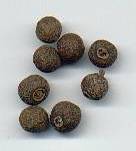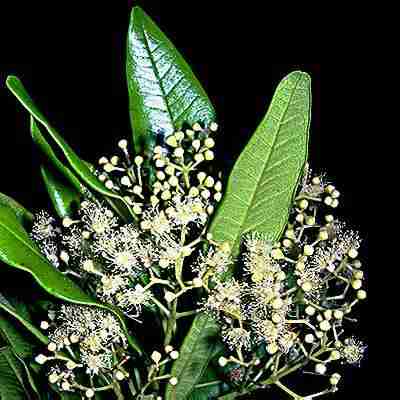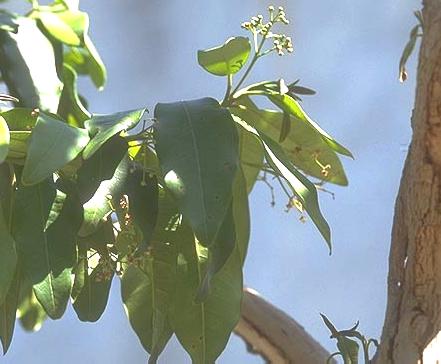[ Plant
part | Family | Aroma
| Constituents | Origin
| Discussion |
- Synonyms
| bot
|
Pimenta officinalis |
| pharm
|
Fructus Amoni, Fructus
Pimentae |
| Arabic
|
Bahar, Bhar hub wa na'im |
| Danish
|
Allehånde |
| Dutch
|
Jamaica peper, Piment |
| English
|
Jamaica pepper, Myrtle
pepper, Pimento, Newspice |
| Estonian
|
Harilik pimendipuu, Vürts |
| Finnish
|
Maustepippuri |
| French
|
Piment, Piment jamaique,
Poivre aromatique, Toute-épice, Poivre de la
Jamaique |
| German
|
Piment, Neugewürz,
Allgewürz, Nelkenpfeffer, Jamaicapfeffer,
Englisches Gewürz |
| Hungarian
|
Jamaikai szegfûbors,
Szegfûbors, Pimento, Amomummag |
| Icelandic
|
Allrahanda |
| Italian
|
Pimento, Pepe di Giamaica |
| Norwegian
|
Allehånde |
| Polish
|
Ziele angielskie |
| Portuguese
|
Pimenta da Jamaica |
| Russian
|
Yamaiskiy pjerets |
| Spanish
|
Pimienta de Jamaica,
Pimienta gorda |
| Swedish
|
Kryddpeppar |
| Turkish
|
Yeni bahar |

|
| Dried allspice fruits |
- Used plant part
- Unripe and dried fruits. In the countries of origin, the
fresh leaves are also much used for cooking or smoking
meat ("West Indian bay-leaf"). Some books,
though, state that West Indian bay-leaves stem from the
closely related P. racemosa. The Mediterranean bay
leaves are an inappropriate substitute.
The essential oil from the leaves (West Indian Bay Oil)
is of importance in the industrial production of
sausages.
- Plant family
- Myrtaceae (myrtle family).
- Sensoric quality
- Strongly aromatic, like cloves with a hint of cinnamon
and nutmeg; the taste is similar, but with some peppery
heat.
- Main constituents
- The fruits contain 2 to 5% essential oil (the exact
content depends much on the time of harvest). Main
component is eugenol (65 to 85%), but also eugenol methyl
ether, 1,8-cineol and alpha-phellandrene are reported.
The
leaves contain less essential oil, but the content is
high enough to make destillation profitable. In
composition, it is similar to the essential oil from the
fruits.
- Origin
- Jamaica, which is also the main exporter. Several other
Central American states (e.g, México, Honduras) produce
this spice, but their quality is considered inferior. The
fruits of P. racemosa, a closely related species,
are sometimes used to adulterate allspice.
- Etymology
- Allspice became known in Europe long after its was first
discovered by an expedition of Columbus; because of the
shape (similar to pepper corns), the new grains were
termed "pepper" (whether by mistake or to gain
more publicity I do not know). Still, they are called
"pepper" in many languages, mostly with an
attribute indicating their Caribbean origin (Russian Yamaiskiy
pjerets "Jamaica pepper") or aromatic scent
(French poivre aromatique "aromatic
pepper", German Nelkenpfeffer "clove
pepper" or Swedish kryddpeppar
"condiment pepper"). Newspice (or German
Neugewürz), too, refers to their origin from the
New World, and allspice (French toute-épice)
reflects the complex aroma of this spice.
The genus
name Pimenta comes from Spanish pimienta
for black pepper; it has a confusing history. In late
Latin, the word pigmentum "dye" took a
new, additional meaning, "spice, condiment".
The Iberic languages, then, formed their word for
"pepper" not from Latin piper
"pepper", but from said pigmentum:
Spanish pimienta, Portuguese pimenta (in
Spanish, however, pebre "pepper" has
been conserved regionally). Since allspice was initially
also termed pimienta by the Spaniards, who alone
imported the spice to 16.th century Europe, the name was,
together with the spice, introduced into many European
languages.
The genus name dioica (Greek di- from dýo
"two", oîkos "house")
indicates that there male and female flowers grow an
different plants; botanists call such plants dioicious.
In Caribbean cuisine, allspice with its
pleasing clove-like aroma is the most important spice and used
extensively. Meat is often stuffed with allspice leaves and
barbecued over a fire of allspice wood, similar to the use of
myrtle around the Mediterranean Sea.
Jamaica is known for its fiery jerk pastes, which are
commonly used to marinate pork or chicken before barbecuing. Jerk
is made mostly of sonion and local chile cultivars of unmatched
heat and pungency. The paste derives is characteristic taste from
allspice berries, furthermore allspice or cinnamon leaves,
garlic, fresh thyme, black pepper and vinegar or lime juice; the
recipe is variable and may include further seasonings like orange
juice, coriander leaves, ginger, nutmeg and cinnamon.
Authenticity is increased by adding dry allspice branches to the
firewood.
Allspice is also grown in México, albeit in lesser quality.
It is used there for the famous mole sauces (see paprika).
In Europe, England consumes most of it. The British like it
for stews and sauces and for flavouring pickled vegetables
(together with white mustard seeds). Allspice is also quite
popular in the US, where cooks use if for quite similar purposes.
On the European continent, allspice is less appreciated; it
is, however, contained in commercial spice mixtures for sausages
and much loved by Scandinavians for fine meat pastries, as are
used in the Danish speciality smørrebrød (white bread
topped with a selection of sausages, pastries, fish, cheese and
vegetables). Other spices popular in Scandinavia are dill and
cardamom seeds.
Allspice berries sometimes show up in the somewhat antiquated
French spice mixture quatre épices (see nutmeg).
It is interesting to note that allspice has not been accepted
by Asian cooks, although its occurrence in curry powder is
sometimes claimed (see curry leaves). The pungent-aromatic
quality of allspice is, however, much in line with Arabic cooking
style; it is rather surprising that allspice is not called for in
Arabic mutton dishes. I guess this is not a matter of taste but
of availability, since allspice is nowhere grown in Asia. The
only cuisine of the Old World using allspice lies in East Africa:
The Ethiopian spice mixture berebere (see long pepper)
indeed contains allspice, which is grown on the island Réunion
not far away.


